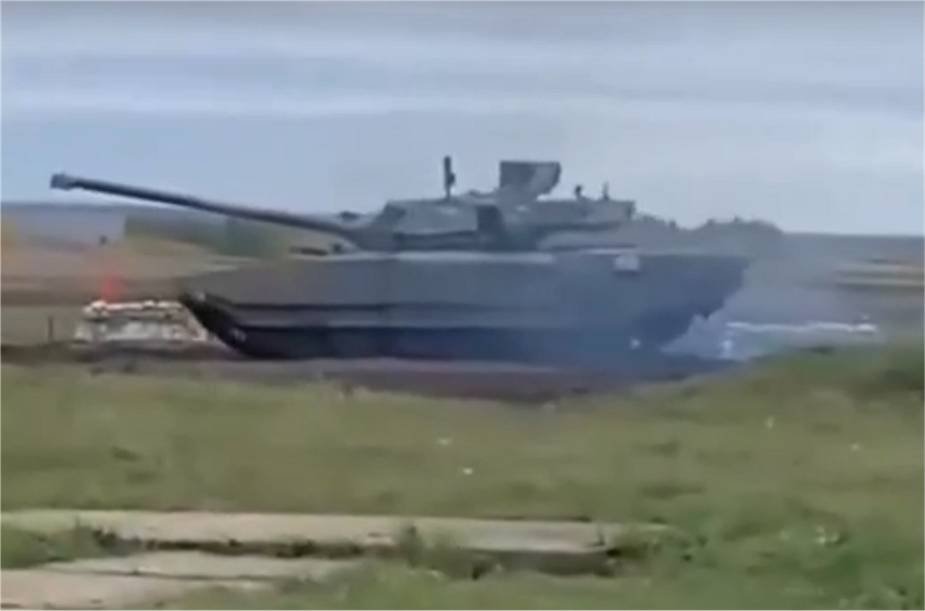Russian soldiers train with T-14 Armata tanks for future deployment in Ukraine
According to an article published by TASS on July 19, 2023, the advanced T-14 Armata main battle tanks (MBT) have recently been used in combat by Russia's battlegroup South, as confirmed by a source from the Russian defense industry. While there is no visual confirmation available, this report could potentially be the first official acknowledgment of the deployment of the T-14 Armata tank in Ukraine to conduct combat operations.
Follow Army Recognition on Google News at this link

Photo was taken from a video showing a T-14 Armata in a Russian training center (Picture source: VK Video Archive)
As per the source, "Armata tanks were actively utilized in combat operations by members of battlegroup South. Several vehicles were deployed to assess the tank's performance and subsequently withdrawn from the frontlines."
An additional source informed the agency that the T-14 Armata main battle tank has already been incorporated into the service of units belonging to the Southern Military District. The source added, "Trials of the T-14 tank are still ongoing."
Official information regarding the specific military operations where the Armata was potentially used has not been released thus far.
On April 25, 2023, the Army Recognition editorial team reported that the Russian army deployed the T-14 Armata tanks in Ukraine to target Ukrainian forces. However, these tanks have not been involved in any direct attack missions so far.
On February 14, 2023, the Army Recognition editorial team reported that Russian soldiers had commenced training with the T-14 Armata tanks in preparation for possible deployment to Ukraine. According to information from Russian sources, the deployment of T-14 Armata tanks in Ukraine aims to counter the Leopard 2A6, Challenger 2, and M1A1 Abrams tanks promised by the United States and European nations.
The T-14 Armata from Russia and the Leopard 2A6 from Germany represent two different designs of modern main battle tanks.
The T-14 Armata is known for its advanced protection. It uses a combination of composite armor, explosive reactive armor, and an advanced Active Protection System (APS) named Afghanit, which is capable of detecting and intercepting incoming projectiles. The Armata features a completely unmanned turret and a separate compartment to house the crew, away from the ammunition. This design choice significantly reduces the likelihood of crew casualties if the tank gets hit.
On the other hand, the Leopard 2A6 also offers robust protection but places more emphasis on traditional passive armor and doesn't have an APS as advanced as the Armata's. The Leopard 2A6 does not have an unmanned turret; it follows the conventional design with the crew compartment within the turret itself. However, the Leopard 2A6 has a smoothbore gun known for its accuracy, power and an excellent fire control system that allows the tank to fire effectively while on the move.
So, the T-14 Armata emphasizes advanced protective technologies and an unconventional design, while the Leopard 2A6 relies more on high-accuracy firepower and a more traditional tank design. The effectiveness of each tank would depend largely on the specific circumstances and the strategies employed by their operators.
The T-14 Armata is a next-generation main battle tank developed and designed by Russia's Uralvagonzavod, a leading tank manufacturer. Its development began in the early 2010s as part of the Armata Universal Combat Platform, aiming to create a versatile and modular system adaptable for various combat roles.
The T-14 Armata exhibits a revolutionary design compared to its predecessors like the T-72, T-80, and T-90 tanks. One notable difference is its unmanned turret, housing the primary weapon and an autoloader. The three-person crew is located in an armored capsule at the front of the hull, separate from the turret. This design enhances crew survivability and results in a lower overall profile.
Another innovative aspect of the T-14 Armata is its extensive use of advanced electronics and automation systems. The tank is equipped with a sophisticated fire control system, multiple high-resolution cameras, and advanced sensors, providing the crew with comprehensive situational awareness and facilitating rapid target acquisition.
The T-14 Armata also emphasizes modularity, enabling upgrades and customization based on mission requirements. This flexibility allows the tank to adapt easily to various roles such as reconnaissance, infantry support, or heavy assault.
The Uralvagonzavod defense manufacturer publicly unveiled the T-14 Armata tank during the 2015 Victory Day Parade in Moscow. Since then, it has undergone extensive testing and trials, with plans to gradually replace Russia's older tank models as part of the country's military modernization efforts.
The T-14 Armata is an advanced main battle tank that distinguishes itself with several unique technologies and innovations. Its key features include an unmanned turret for a lower profile and increased crew survivability. The primary weapon and autoloader are housed in the turret, while the crew is protected in an armored capsule at the front of the hull.
The armored capsule ensures that the three-person crew remains separate from the turret and ammunition storage, significantly improving survivability in the event of a hit or ammunition detonation. Additionally, the T-14 Armata is equipped with the Afganit Active Protection System (APS), which utilizes radar and other sensors to detect and intercept incoming projectiles, providing an additional layer of defense.
The advanced fire control system enables rapid target acquisition and improved accuracy by integrating data from multiple sensors, including high-resolution cameras, thermal imagers, and laser rangefinders. The T-14 Armata's modular design, based on the Armata Universal Combat Platform, allows for easy upgrades and customization to fulfill various roles, including infantry support, reconnaissance, and heavy assault.
Powered by a 1,500-horsepower diesel engine, the T-14 Armata can achieve speeds of approximately 56 mph (90 kph). Its advanced suspension system and relatively low weight contribute to impressive maneuverability and off-road capabilities. Moreover, the T-14 Armata is designed to function within a larger networked battle space, integrating with other platforms and sharing data to enhance situational awareness and facilitate effective coordination among units.























